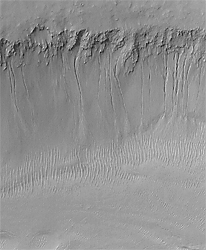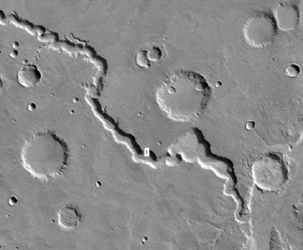
Mars Global Surveyor
Mars Orbiter Camera
Evidence for Recent Liquid Water on Mars:
South-facing Walls of Nirgal Vallis
MGS MOC Release No. MOC2-240, 22 June 2000
|
(A) Nirgal Vallis Wall

|
(B) Viking Context View

|
Nirgal Vallis is an ancient valley thought for nearly 3 decades to have
been carved, in part, by running water at some time far back in the martian
past. Today the valley is, like the rest of Mars, quite dry. However, some
of the high resolution Mars Global Surveyor (MGS) Mars Orbiter Camera (MOC)
images reveal small gullies on the walls of this valley system. An example
is shown here (above, left), in which more than 14 channels nearly 1 kilometer
(0.6 miles) long run down the south-facing slope of the Nirgal Vallis wall.
Each narrow channel starts at about the same position below the top of
the valley wall, indicating that there is a layer along which a liquid--most
likely, water--has percolated until it reached the cliff, then ran down
hill to form the channels and the fan-shaped aprons at the bottom of the
slope. Some of the apron deposits seem to cover the dunes on the floor
of the valley (lower 1/3 of the image), suggesting that the channels and
aprons formed more recently than the dunes. The fact that neither the dunes
nor the aprons and channels have impact craters on them suggests that these
features are all geologically young, meaning a few million years at most,
a few days or weeks at least.
Nirgal Vallis is the one location where martian gullies thought
to be related to recent groundwater seepage have been found closer to the
equator than 30° latitude. All of the features in Nirgal, however,
occur close to 30°--they are all between 27°S and 30°S. The
MOC image is near 29.7°S, 38.6°W, and was obtained July 12, 1999.
The MOC picture covers an area approximately 2.3 km (1.4 mi) wide by 2.8
km (1.7 mi) long. Sunlight illuminates the MOC scene from the upper left,
and north is up. The context view (right) is a mosaic of Viking orbiter
images illuminated from the upper right from the U.S. Geological Survey
Mars Digital Mosaic maps. The small white box in the context frame (just
below center of image) shows the location of the high resolution MOC view.
It is ironic to note that one of the first pictures
returned to Earth from MOC, back on September 21, 1997, showed similar
small channels and aprons on the wall of Nirgal Vallis--but their significance
was not realized at the time.
Images Credit: NASA/JPL/Malin Space Science Systems
Malin Space Science Systems and the California Institute
of Technology built the MOC using spare hardware from the Mars Observer
mission. MSSS operates the camera from its facilities in San Diego, CA.
The Jet Propulsion Laboratory's Mars Surveyor Operations Project operates
the Mars Global Surveyor spacecraft with its industrial partner, Lockheed
Martin Astronautics, from facilities in Pasadena, CA and Denver, CO.
 To
MSSS Home Page
To
MSSS Home Page

